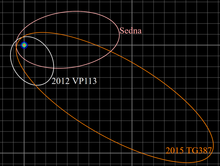
Back Sednoïde Afrikaans سدناوي Arabic Sednoid German Sednoide Spanish Sednoide Basque Sednoïde French Sednoide Galician सेडनोई Hindi Sednoid ID Sednoide Italian



A sednoid is a trans-Neptunian object with a large semi-major axis and a high perihelion, similar to the orbit of the dwarf planet Sedna. The consensus among astronomers is that there are only three objects that are known from this population: Sedna, 2012 VP113, and 541132 Leleākūhonua (2015 TG387).[1] All three have perihelia greater than 60 AU.[2] These objects lie outside an apparently nearly empty gap in the Solar System and have no significant interaction with the planets. They are usually grouped with the detached objects. Some astronomers[3] consider the sednoids to be Inner Oort Cloud (IOC) objects, though the inner Oort cloud, or Hills cloud, was originally predicted to lie beyond 2,000 AU, beyond the aphelia of the three known sednoids.
One attempt at a precise definition of sednoids is any body with a perihelion greater than 50 AU and a semi-major axis greater than 150 AU.[4][5] However, this definition applies to objects such as 2013 SY99 and 2021 RR205,[6] which have perihelia beyond 50 AU and semi-major axes over 700 AU. Despite this, these objects are thought to not belong to the sednoids, but rather to the same dynamical class as 474640 Alicanto, 2014 SR349 and 2010 GB174.[7][1]
With their high eccentricities (greater than 0.8), sednoids are distinguished from the high-perihelion objects with moderate eccentricities that are in a stable resonance with Neptune, namely 2015 KQ174, 2015 FJ345, (612911) 2004 XR190 ("Buffy"), 2014 FC72 and 2014 FZ71.[8]
- ^ a b Cite error: The named reference
Huang2024was invoked but never defined (see the help page). - ^ Cite error: The named reference
JPL-sednoidwas invoked but never defined (see the help page). - ^ Cite error: The named reference
Sheppard-Inner-Oort-Cloudwas invoked but never defined (see the help page). - ^ Cite error: The named reference
nature letterwas invoked but never defined (see the help page). - ^ Cite error: The named reference
Sheppard-Extremewas invoked but never defined (see the help page). - ^ Cite error: The named reference
Sheppard-discwas invoked but never defined (see the help page). - ^ Cite error: The named reference
Bannister2017was invoked but never defined (see the help page). - ^ Cite error: The named reference
Like Buffywas invoked but never defined (see the help page).